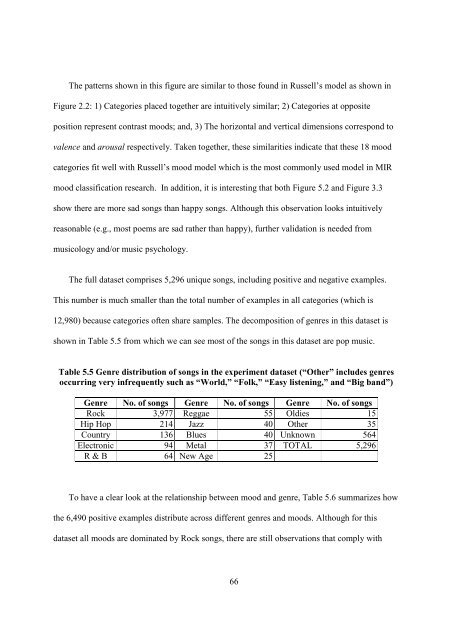improving music mood classification using lyrics, audio and social tags
improving music mood classification using lyrics, audio and social tags
improving music mood classification using lyrics, audio and social tags
You also want an ePaper? Increase the reach of your titles
YUMPU automatically turns print PDFs into web optimized ePapers that Google loves.
The patterns shown in this figure are similar to those found in Russell’s model as shown in<br />
Figure 2.2: 1) Categories placed together are intuitively similar; 2) Categories at opposite<br />
position represent contrast <strong>mood</strong>s; <strong>and</strong>, 3) The horizontal <strong>and</strong> vertical dimensions correspond to<br />
valence <strong>and</strong> arousal respectively. Taken together, these similarities indicate that these 18 <strong>mood</strong><br />
categories fit well with Russell’s <strong>mood</strong> model which is the most commonly used model in MIR<br />
<strong>mood</strong> <strong>classification</strong> research. In addition, it is interesting that both Figure 5.2 <strong>and</strong> Figure 3.3<br />
show there are more sad songs than happy songs. Although this observation looks intuitively<br />
reasonable (e.g., most poems are sad rather than happy), further validation is needed from<br />
<strong>music</strong>ology <strong>and</strong>/or <strong>music</strong> psychology.<br />
The full dataset comprises 5,296 unique songs, including positive <strong>and</strong> negative examples.<br />
This number is much smaller than the total number of examples in all categories (which is<br />
12,980) because categories often share samples. The decomposition of genres in this dataset is<br />
shown in Table 5.5 from which we can see most of the songs in this dataset are pop <strong>music</strong>.<br />
Table 5.5 Genre distribution of songs in the experiment dataset (“Other” includes genres<br />
occurring very infrequently such as “World,” “Folk,” “Easy listening,” <strong>and</strong> “Big b<strong>and</strong>”)<br />
Genre No. of songs Genre No. of songs Genre No. of songs<br />
Rock 3,977 Reggae 55 Oldies 15<br />
Hip Hop 214 Jazz 40 Other 35<br />
Country 136 Blues 40 Unknown 564<br />
Electronic 94 Metal 37 TOTAL 5,296<br />
R & B 64 New Age 25<br />
To have a clear look at the relationship between <strong>mood</strong> <strong>and</strong> genre, Table 5.6 summarizes how<br />
the 6,490 positive examples distribute across different genres <strong>and</strong> <strong>mood</strong>s. Although for this<br />
dataset all <strong>mood</strong>s are dominated by Rock songs, there are still observations that comply with<br />
66
















